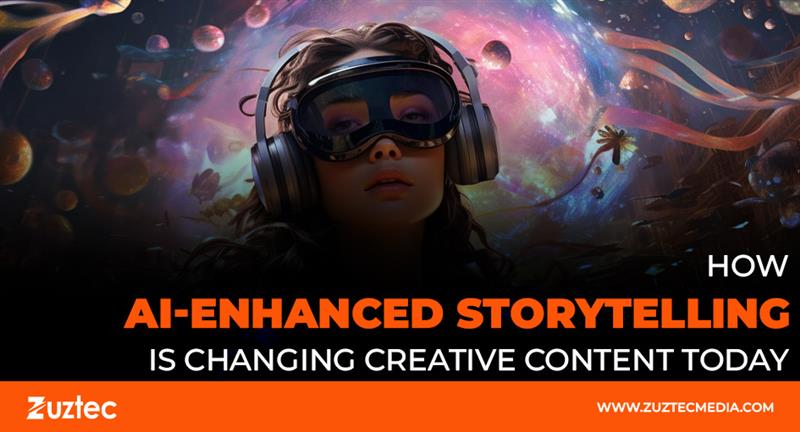
How AI-Enhanced Storytelling Is Changing Creative Content Today
From ancient myths to modern movies, stories shape the way we see the world. But as technology evolves, so does the art of storytelling. One of the most exciting developments in recent years is AI-enhanced storytelling, where artificial intelligence helps create, refine, and even personalize content in real time.
This new approach to storytelling is transforming the way writers, marketers, filmmakers, and content creators produce narratives. With AI tools, it’s now possible to generate dialogue, build story arcs, and develop characters based on data and audience preferences. This not only speeds up the creative process but also opens new doors for experimentation and innovation.
It isn’t about replacing human creativity—it’s about extending it. Writers can use AI to explore alternative plots, test audience reactions, or generate variations of a single idea. Marketers use AI-driven storytelling to craft more engaging brand messages that resonate with different customer segments. In journalism, AI can help summarize complex topics or personalize news feeds for individual readers.
However, as with any technology, there are concerns. Issues around authenticity, originality, and ethical use of AI in storytelling are already sparking important discussions. In this article, we’ll explore how AI is changing storytelling, its benefits, its challenges, and what the future might hold for creative industries that embrace this powerful tool.
What is AI-enhanced storytelling?
It refers to the use of artificial intelligence to support and improve the process of creating narratives. This can range from generating text or dialogue to analyzing audience responses and suggesting changes in plot direction. AI tools can process large amounts of data quickly, making it easier for creators to craft stories that align with audience interests and trends.
Some tools generate written content automatically, while others assist in visual storytelling by helping with scene descriptions or animations. In some cases, AI is also used to create branching narratives for video games or interactive experiences, adapting stories in real time based on user input.
Benefits of AI in storytelling
There are several key advantages to using AI in the storytelling process:
- Speed: AI can produce drafts or creative ideas much faster than traditional methods.
- Personalization: Stories can be tailored for different audience groups using data insights.
- Consistency: For large content projects, AI helps maintain tone, style, and structure across platforms.
These benefits make AI a valuable tool for writers, filmmakers, marketers, and content strategists who want to work faster and smarter without compromising quality.
Use cases across industries
It is already being used in several industries:
- Marketing: Brands use AI to craft targeted stories for different customer personas.
- Journalism: Newsrooms rely on AI to create quick summaries and generate article variations.
- Film and TV: Screenwriters and production teams use AI for script development and scene planning.
- Gaming: Developers use AI to create dynamic narratives that respond to player decisions.
- Education: Educators and edtech companies use AI to build learning stories based on student needs.
These examples show how AI storytelling tools are helping teams reach larger audiences with more relevant, engaging content.
How AI supports human creativity
One of the biggest misconceptions about AI-enhanced storytelling is that it removes the human element. In reality, most AI tools are designed to assist, not replace, creators. Writers use AI to brainstorm ideas, test different tones, or fix grammar. Designers use it to visualize scenes or suggest color schemes. Filmmakers use AI to speed up editing and improve visual effects.
In each case, the creative decision-making still belongs to the human. AI simply provides the raw material or analysis that helps move the process forward. When used thoughtfully, AI enhances creativity by removing routine work and sparking new ideas.
The future of storytelling with AI
As technology continues to improve, the role of AI in storytelling is likely to grow. We can expect more interactive stories that respond to individual users, smarter tools that can understand complex themes, and stronger collaboration between AI and humans.
Some future trends may include:
- AI writers are capable of handling longer, more complex narratives.
- Integration of voice and emotion recognition to build personalized story paths.
- Tools that help marginalized voices tell their stories more easily and widely.
These developments could make storytelling more inclusive, immersive, and accessible across the globe.
Significantly, AI-enhanced storytelling represents a major shift in how stories are created and shared. While it won’t replace human creativity, it will continue to expand what’s possible in writing, film, marketing, and more. By blending human emotion with machine efficiency, AI is helping creators deliver better, faster, and more personalized stories than ever before.
As the technology matures, it will be important to focus on responsible use, transparency, and creativity. When balanced properly, the combination of AI and human storytelling can lead to richer, more impactful content that speaks to diverse audiences around the world.
The future of storytelling is not just human or machine—it’s a creative partnership between both.

